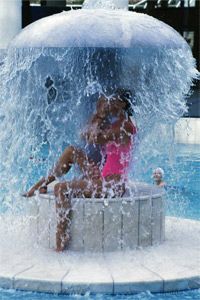In his 1993 novel "The Road to Wellville," T.C. Boyle lampoons Dr. John Harvey Kellogg, the cornflake inventor who also founded a spa in Battle Creek, Mich. The novel is set in 1907-1908 and paints an unflattering picture of both Kellogg and the pseudoscientific treatments he recommends for his "sanitarium" guests. One such therapy is known as the sinusoidal bath, which involves placing a person in tepid water and applying an electric current to the bath. This treatment produces muscular contractions in the patient that are supposed to relieve a number of symptoms. In Boyle's book, the therapy results in the electrocution of one of the spa's residents.
Most modern spa owners and therapists would likely cringe at such an outlandish scene. They know that the therapeutic use of water, or balneotherapy, is a safe and time-tested treatment. Almost all of them have patients who claim that balneotherapy can heal a variety of ailments, from eczema to rheumatoid arthritis. But the jury is still out on the scientific validity of these claims, and the mechanisms of action remain unclear. One thing is very clear: Regardless of scientific evidence proving their efficacy, water-based therapies provide a calming, soothing experience that many consumers appreciate.
Advertisement
Indeed, balneotherapy is a major force driving the growth and expansion of spas. Consider these statistics about the U.S. spa industry from the International Spa Association:
- As of June 2008, there were 18,100 spas.
- The number of spa locations has grown at an annual average of 20 percent in the last eight years.
- There are more than 32 million active spa-goers.
- In 2007, there were 138 million spa visits, generating $10.9 billion of revenue.
- One in four Americans has been to a spa.
- In June 2008, there were 303,700 full-time, part-time and contract employees working in the spa industry.
To understand how balneotherapy contributes to these trends, we need to understand the topic more thoroughly. That means taking a deep dive into both the myth and the medicine behind this favorite spa treatment. Our first order of business is clearly defining balneotherapy.
Advertisement




